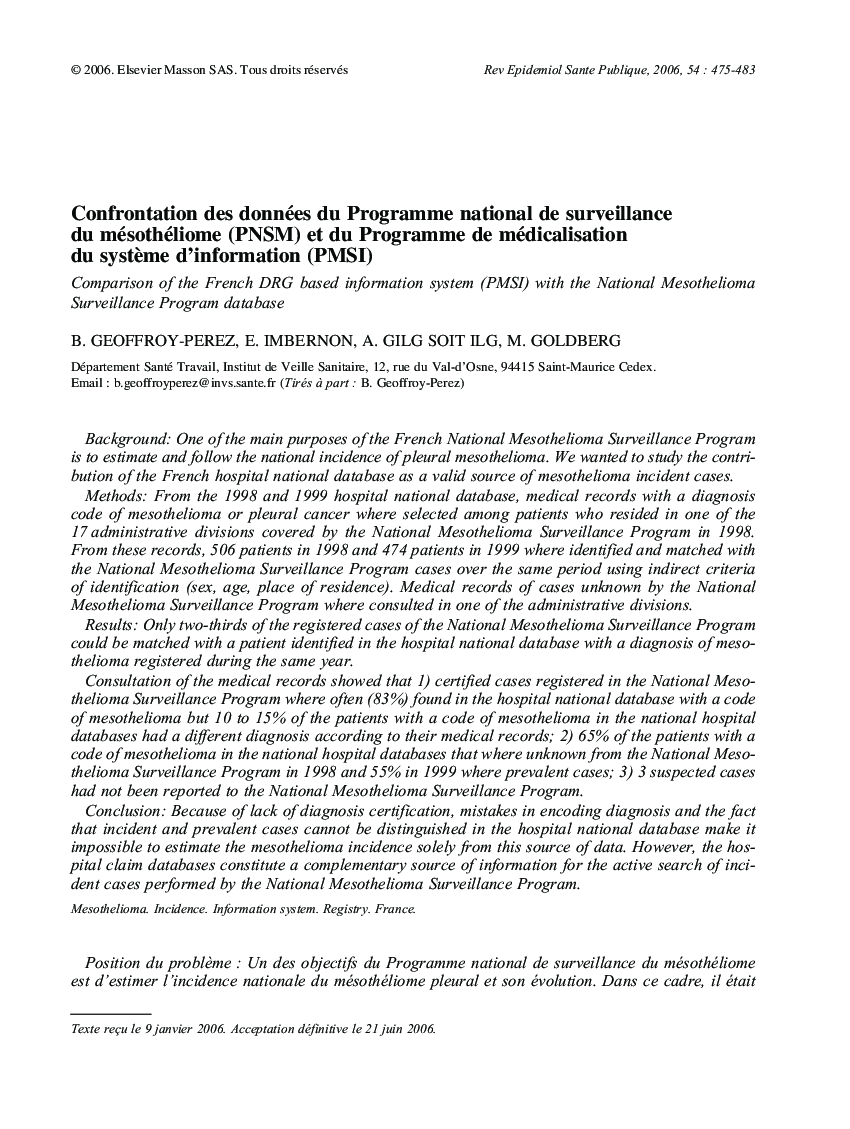| کد مقاله | کد نشریه | سال انتشار | مقاله انگلیسی | نسخه تمام متن |
|---|---|---|---|---|
| 3833792 | 1247280 | 2006 | 9 صفحه PDF | دانلود رایگان |

Position du problèmeUn des objectifs du Programme national de surveillance du mésothéliome est d’estimer l’incidence nationale du mésothéliome pleural et son évolution. Dans ce cadre, il était important d’analyser la possibilité de recourir aux données du Programme de médicalisation des systèmes d’information (PMSI) disponibles à l’échelon national.MéthodesLe dédoublonnage des séjours issus de la base nationale portant le diagnostic de mésothéliome ou de cancer pleural a permis d’identifier 506 patients en 1998 et 474 patients en 1999 résidant dans un des 17 départements couverts par le Programme de surveillance du mésothéliome en 1998. Ces cas ont été appariés sur des critères indirects avec les cas enregistrés dans le Programme national de surveillance du mésothéliome durant la même période. Le retour au dossier du patient a été réalisé dans un département afin de valider la procédure d’appariement et documenter les cas non connus du Programme de surveillance du mésothéliome.RésultatsSeulement 2/3 des cas enregistrés dans le Programme de surveillance du mésothéliome avaient un séjour correspondant dans le PMSI la même année. Le retour au dossier médical a montré que 1) les cas certains du Programme de surveillance du mésothéliome étaient le plus souvent (83 % pour les deux années étudiées) retrouvés dans le PMSI avec un code diagnostic de mésothéliome, mais 10 à 15 % des patients avec un code diagnostic de mésothéliome dans le PMSI avaient un diagnostic différent dans leur dossier médical ; 2) 65 % des patients avec un code diagnostic de mésothéliome dans le PMSI et inconnus du Programme de surveillance du mésothéliome en 1998 et 55 % en 1999 étaient des cas prévalents ; 3) 3 cas suspects de mésothéliome étaient inconnus du Programme de surveillance du mésothéliome.ConclusionL’absence de certification diagnostique, les erreurs de codage et surtout l’impossibilité de distinguer les cas incidents des cas prévalents dans le PMSI empêchent de s’appuyer sur cette seule source de données pour estimer l’incidence du mésothéliome. Elle constitue cependant une source d’informations complémentaires qui devrait être consultée systématiquement et rapprochée des données des registres de mésothéliome au niveau départemental.
BackgroundOne of the main purposes of the French National Mesothelioma Surveillance Program is to estimate and follow the national incidence of pleural mesothelioma. We wanted to study the contribution of the French hospital national database as a valid source of mesothelioma incident cases.MethodsFrom the 1998 and 1999 hospital national database, medical records with a diagnosis code of mesothelioma or pleural cancer where selected among patients who resided in one of the 17 administrative divisions covered by the National Mesothelioma Surveillance Program in 1998. From these records, 506 patients in 1998 and 474 patients in 1999 where identified and matched with the National Mesothelioma Surveillance Program cases over the same period using indirect criteria of identification (sex, age, place of residence). Medical records of cases unknown by the National Mesothelioma Surveillance Program where consulted in one of the administrative divisions.ResultsOnly two-thirds of the registered cases of the National Mesothelioma Surveillance Program could be matched with a patient identified in the hospital national database with a diagnosis of mesothelioma registered during the same year.Consultationof the medical records showed that 1) certified cases registered in the National Mesothelioma Surveillance Program where often (83%) found in the hospital national database with a code of mesothelioma but 10 to 15% of the patients with a code of mesothelioma in the national hospital databases had a different diagnosis according to their medical records; 2) 65% of the patients with a code of mesothelioma in the national hospital databases that where unknown from the National Mesothelioma Surveillance Program in 1998 and 55% in 1999 where prevalent cases; 3) 3 suspected cases had not been reported to the National Mesothelioma Surveillance Program.ConclusionBecause of lack of diagnosis certification, mistakes in encoding diagnosis and the fact that incident and prevalent cases cannot be distinguished in the hospital national database make it impossible to estimate the mesothelioma incidence solely from this source of data. However, the hospital claim databases constitute a complementary source of information for the active search of incident cases performed by the National Mesothelioma Surveillance Program.
Journal: Revue d'Épidémiologie et de Santé Publique - Volume 54, Issue 6, December 2006, Pages 475-483